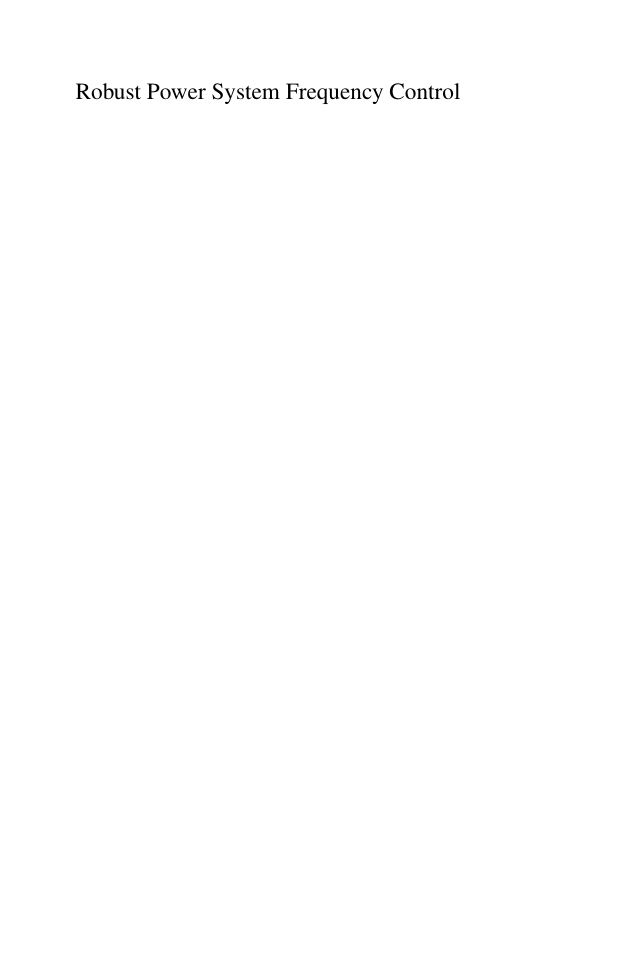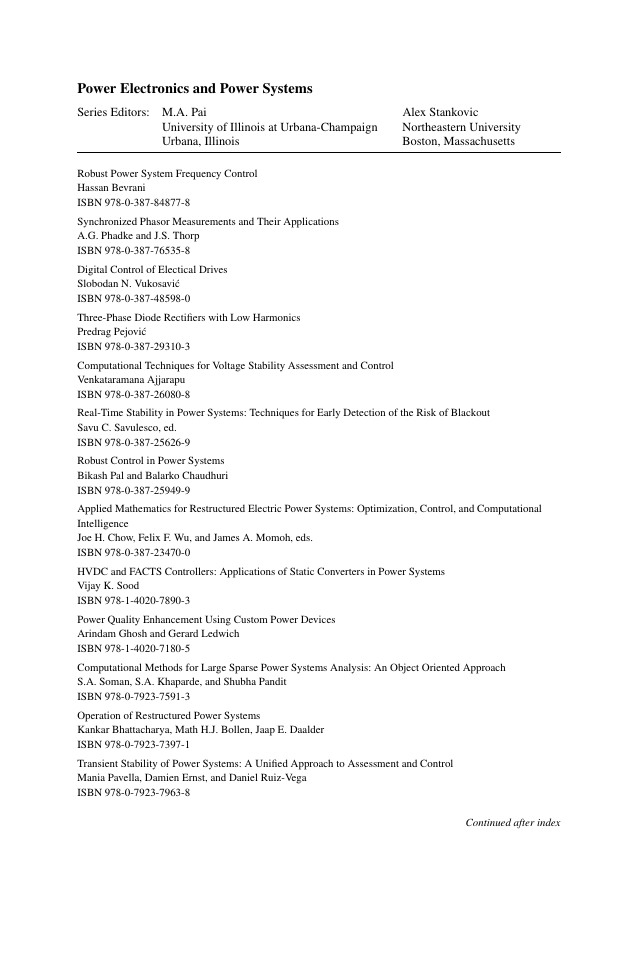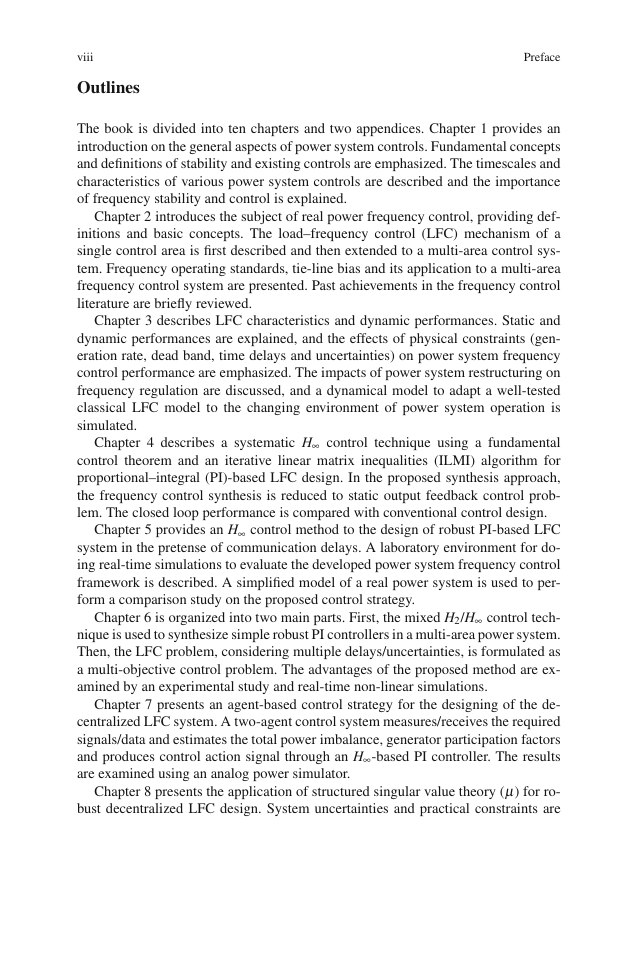Robust Power System Frequency Control
�
Power Electronics and Power Systems
Series Editors: M.A. Pai
University of Illinois at Urbana-Champaign
Urbana, Illinois
Alex Stankovic
Northeastern University
Boston, Massachusetts
Robust Power System Frequency Control
Hassan Bevrani
ISBN 978-0-387-84877-8
Synchronized Phasor Measurements and Their Applications
A.G. Phadke and J.S. Thorp
ISBN 978-0-387-76535-8
Digital Control of Electical Drives
Slobodan N. Vukosavi´c
ISBN 978-0-387-48598-0
Three-Phase Diode Rectifiers with Low Harmonics
Predrag Pejovi´c
ISBN 978-0-387-29310-3
Computational Techniques for Voltage Stability Assessment and Control
Venkataramana Ajjarapu
ISBN 978-0-387-26080-8
Real-Time Stability in Power Systems: Techniques for Early Detection of the Risk of Blackout
Savu C. Savulesco, ed.
ISBN 978-0-387-25626-9
Robust Control in Power Systems
Bikash Pal and Balarko Chaudhuri
ISBN 978-0-387-25949-9
Applied Mathematics for Restructured Electric Power Systems: Optimization, Control, and Computational
Intelligence
Joe H. Chow, Felix F. Wu, and James A. Momoh, eds.
ISBN 978-0-387-23470-0
HVDC and FACTS Controllers: Applications of Static Converters in Power Systems
Vijay K. Sood
ISBN 978-1-4020-7890-3
Power Quality Enhancement Using Custom Power Devices
Arindam Ghosh and Gerard Ledwich
ISBN 978-1-4020-7180-5
Computational Methods for Large Sparse Power Systems Analysis: An Object Oriented Approach
S.A. Soman, S.A. Khaparde, and Shubha Pandit
ISBN 978-0-7923-7591-3
Operation of Restructured Power Systems
Kankar Bhattacharya, Math H.J. Bollen, Jaap E. Daalder
ISBN 978-0-7923-7397-1
Transient Stability of Power Systems: A Unified Approach to Assessment and Control
Mania Pavella, Damien Ernst, and Daniel Ruiz-Vega
ISBN 978-0-7923-7963-8
Continued after index
�
Hassan Bevrani
Robust Power System
Frequency Control
ABC
�
Hassan Bevrani
University of Kurdistan
Sanandaj, Kurdistan
Iran
bevrani@uok.ac.ir
Queensland University of Technology
Brisbane, QLD
Australia
bevrani@qut.edu.au
ISBN: 978-0-387-84877-8
DOI: 10.1007/978-0-387-84878-5
e-ISBN: 978-0-387-84878-5
Library of Congress Control Number: 2008934165
c 2009 Springer Science+Business Media, LLC
All rights reserved. This work may not be translated or copied in whole or in part without the written
permission of the publisher (Springer Science+Business Media, LLC, 233 Spring Street, New York, NY
10013, USA), except for brief excerpts in connection with reviews or scholarly analysis. Use in connection
with any form of information storage and retrieval, electronic adaptation, computer software, or by similar
or dissimilar methodology now known or hereafter developed is forbidden. The use in this publication of
trade names, trademarks, service marks, and similar terms, even if they are not identified as such, is not to
be taken as an expression of opinion as to whether or not they are subject to proprietary rights.
While the advice and information in this book are believed to be true and accurate at the date of going
to press, neither the authors nor the editors nor the publisher can accept any legal responsibility for any
errors or omissions that may be made. The publisher makes no warranty, express or implied, with respect
to the material contained herein.
Printed on acid-free paper
springer.com
�
Dedicated to my parents
�
Preface
Frequency control as a major function of automatic generation control is one of the
important control problems in electric power system design and operation, and is
becoming more significant today because of the increasing size, changing structure,
emerging new uncertainties, environmental constraints and the complexity of power
systems.
In the last two decades, many studies have focused on damping control and volt-
age stability and the related issues, but there has been much less work on the power
system frequency control analysis and synthesis. While some aspects of frequency
control have been illustrated along with individual chapters, many conferences and
technical papers, a comprehensive and sensible practical explanation of robust fre-
quency control in a book form is necessary.
This book provides a thorough understanding of the basic principles of power
system frequency behaviour in wide range of operating conditions. It uses simple
frequency response models, control structures and mathematical algorithms to adapt
modern robust control theorems with frequency control issue and conceptual expla-
nations. Most developed control strategies are examined by real-time simulations.
Practical methods for computer analysis and design are emphasized.
This book emphasizes the physical and engineering aspects of the power sys-
tem frequency control design problem, providing a conceptual understanding of
frequency regulation, and application of robust control techniques. The main aim
is to develop an appropriate intuition relative to the robust load frequency regulation
problem in real-world power systems, rather than to describe sophisticated mathe-
matical analytical methods.
This book could be useful for engineers and operators in power system planning
and operation, as well as for academic researchers. It could be useful as a supple-
mentary text for university students in electrical engineering at both undergraduate
and postgraduate levels in standard courses of power system dynamics, power sys-
tem analysis and power system stability and control.
vii
�
viii
Outlines
Preface
The book is divided into ten chapters and two appendices. Chapter 1 provides an
introduction on the general aspects of power system controls. Fundamental concepts
and definitions of stability and existing controls are emphasized. The timescales and
characteristics of various power system controls are described and the importance
of frequency stability and control is explained.
Chapter 2 introduces the subject of real power frequency control, providing def-
initions and basic concepts. The load–frequency control (LFC) mechanism of a
single control area is first described and then extended to a multi-area control sys-
tem. Frequency operating standards, tie-line bias and its application to a multi-area
frequency control system are presented. Past achievements in the frequency control
literature are briefly reviewed.
Chapter 3 describes LFC characteristics and dynamic performances. Static and
dynamic performances are explained, and the effects of physical constraints (gen-
eration rate, dead band, time delays and uncertainties) on power system frequency
control performance are emphasized. The impacts of power system restructuring on
frequency regulation are discussed, and a dynamical model to adapt a well-tested
classical LFC model to the changing environment of power system operation is
simulated.
Chapter 4 describes a systematic H∞ control technique using a fundamental
control theorem and an iterative linear matrix inequalities (ILMI) algorithm for
proportional–integral (PI)-based LFC design. In the proposed synthesis approach,
the frequency control synthesis is reduced to static output feedback control prob-
lem. The closed loop performance is compared with conventional control design.
Chapter 5 provides an H∞ control method to the design of robust PI-based LFC
system in the pretense of communication delays. A laboratory environment for do-
ing real-time simulations to evaluate the developed power system frequency control
framework is described. A simplified model of a real power system is used to per-
form a comparison study on the proposed control strategy.
Chapter 6 is organized into two main parts. First, the mixed H2/H∞ control tech-
nique is used to synthesize simple robust PI controllers in a multi-area power system.
Then, the LFC problem, considering multiple delays/uncertainties, is formulated as
a multi-objective control problem. The advantages of the proposed method are ex-
amined by an experimental study and real-time non-linear simulations.
Chapter 7 presents an agent-based control strategy for the designing of the de-
centralized LFC system. A two-agent control system measures/receives the required
signals/data and estimates the total power imbalance, generator participation factors
and produces control action signal through an H∞-based PI controller. The results
are examined using an analog power simulator.
Chapter 8 presents the application of structured singular value theory (μ) for ro-
bust decentralized LFC design. System uncertainties and practical constraints are
�
Preface
ix
properly considered during a synthesis procedure. The robust performance is for-
mulated in terms of the structured singular value for the measuring of control per-
formance within a systematic approach.
Chapter 9 describes the power system frequency behaviour in emergency condi-
tions. The conventional frequency response model is generalized by considering the
dynamics of emergency control/protection schemes such as under-frequency load
shedding (UFLS) and under-frequency/over-frequency generation trips. A method
for UFLS by using the regional frequency decline rate is proposed.
Chapter 10 presents an overview of the key issues and the new challenges on
frequency regulation, concerning the integration of renewable energy units into the
power systems. The impact of power fluctuation produced by variable wind and so-
lar renewable sources on system frequency performance via a simulation study is
analysed. An updated LFC model is introduced, and the need for the revising of fre-
quency performance standards is emphasized. Finally, a brief survey on the recent
studies on the frequency regulation in the presence of renewable energy resources
(RESs) and associated issues is presented. Appendices include mathematical de-
scriptions and simulation data.
Acknowledgements
Much of the information, outcomes and insight presented in this book were achieved
through a long-term research conducted by the author on robust control and power
system frequency regulation over the last 15 years in Iran (1993–2002: K.N. Toosi
University of Technology, West Regional Electric Company, and University of
Kurdistan), Japan (2002–2006: Osaka University, Kumamoto University and Re-
search laboratory of Kyushu Electric Power Company) and Australia (2007–2008:
Queensland University of Technology).
It is pleasure to acknowledge the scholarships, awards and support the author
received from various sources: The Ministry of Education, Culture, Sports, Science
and Technology, Government of Japan (Monbukagakusho); Japan Society for the
Promotion of Science (JSPS); West Regional Electric Company (WREC); Research
Office at University of Kurdistan (UOK) and the Australian Research Council
(ARC).
The author thanks Prof. T. Hiyama (Kumamoto University), Prof. Y. Mitani
(Kyushu Institute of Technology), Prof. K. Tsuji (Osaka University), Prof.
G. Ledwich and Prof. Arindam Ghosh (Queensland University of Technology)
for their continuous support and valuable comments. The assistance provided by
Dr. J.J. Ford, Dr. J. Banks and Ms J. Stanbrook (Queensland University of Tech-
nology) is appreciated. Special thanks go to Prof. M.A. Pai (University of Illinois)
for his support to provide this book. Finally, the author offers his deepest personal
gratitude to his family for their support and patience during his work on this book.
�
















 2023年江西萍乡中考道德与法治真题及答案.doc
2023年江西萍乡中考道德与法治真题及答案.doc 2012年重庆南川中考生物真题及答案.doc
2012年重庆南川中考生物真题及答案.doc 2013年江西师范大学地理学综合及文艺理论基础考研真题.doc
2013年江西师范大学地理学综合及文艺理论基础考研真题.doc 2020年四川甘孜小升初语文真题及答案I卷.doc
2020年四川甘孜小升初语文真题及答案I卷.doc 2020年注册岩土工程师专业基础考试真题及答案.doc
2020年注册岩土工程师专业基础考试真题及答案.doc 2023-2024学年福建省厦门市九年级上学期数学月考试题及答案.doc
2023-2024学年福建省厦门市九年级上学期数学月考试题及答案.doc 2021-2022学年辽宁省沈阳市大东区九年级上学期语文期末试题及答案.doc
2021-2022学年辽宁省沈阳市大东区九年级上学期语文期末试题及答案.doc 2022-2023学年北京东城区初三第一学期物理期末试卷及答案.doc
2022-2023学年北京东城区初三第一学期物理期末试卷及答案.doc 2018上半年江西教师资格初中地理学科知识与教学能力真题及答案.doc
2018上半年江西教师资格初中地理学科知识与教学能力真题及答案.doc 2012年河北国家公务员申论考试真题及答案-省级.doc
2012年河北国家公务员申论考试真题及答案-省级.doc 2020-2021学年江苏省扬州市江都区邵樊片九年级上学期数学第一次质量检测试题及答案.doc
2020-2021学年江苏省扬州市江都区邵樊片九年级上学期数学第一次质量检测试题及答案.doc 2022下半年黑龙江教师资格证中学综合素质真题及答案.doc
2022下半年黑龙江教师资格证中学综合素质真题及答案.doc